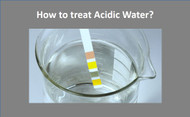How to Treat Acidic Water?
Posted by David Cannon on 28th Jul 2020

The water flowing from the tap should be clean and clear, and this is the primary necessity of all living organisms. However, even clear water contains a small number of dissolved minerals, volatile organic chemicals, microorganisms, and even lead from pipes. The chemicals and minerals may make the water acidic, and hence it needs to be treated before consumption. One of the effective ways to monitor these acidic minerals and chemicals is to regularly test your water and perform a pH test without fail. pH means the potential of hydrogen ions that indicates how acidic or alkaline the water is. It is measured on the scale that runs from 0 to 14. A pH of 7 is neutral, which means there is a balance between acidity and alkalinity. A pH value greater than 7 is alkaline and that less than 7 is acidic. Very high or very low pH water is corrosive, which can leach metals from fixtures, also damage metal pipes and cause aesthetic problems including sour taste, staining in drains and sinks. To avoid such issues, it is important to treat acidic water, which may be from a well most times. This post discusses some common treatments to neutralize the pH level in the water. So, stay tuned.
What Treatments Are Used for Managing pH Level in Drinking Water?
Here are two commonly used methods to adjust pH levels in drinking water.
- Acid Neutralizing Filters: This is one of the best ways to neutralize the pH level in the water. In this, the water flows into a pressurized tank containing calcium carbonate (often called calcite). Since the water absorbs these minerals, the alkalinity and hardness increases. This method works well for the water that has a pH of 5.5 or higher. The tank comprises an automatic backwashing valve that backflushes the calcite to the drain for minutes to remove precipitated iron and solids. This process of raising the pH level adds hardness back to the water. So, in many cases, a water softener is used to remove the hardness added in the neutralizing process.
- Chemical Feed Pump Systems: This method is superior and works well on low pH water. As the name implies, it involves a chemical feed pump to inject a precise amount of soda ash solution to the water to increase the pH level. Usually called as a proportional pH balancing system, this ensures the pH is uniform regardless of flow rate without adding hardness back to the water. Soda ash is basically just sodium carbonate. Neutralizing the pH level with soda ash slightly increases the sodium level of the water. So, those on low sodium will need to make some adjustments.
Clean and clear water is the utmost necessity of all living organisms. So, it is important not to judge the water quality only by its appearance, and make sure it has the right pH level. If you are still confused about which treatment to prefer to manage the pH level of your water, it is always better to approach industry-leading suppliers who have been regularly supplying essential systems that help to neutralize the pH level of water. Perhaps, they will help you make the right selection. Cannon Water Technology is one leading suppliers of simple and well-engineered chemical pump systems which optimize the pH level of water. They also offer a wide range of filtration systems including centrifugal sand separators from SandMaster collection.
